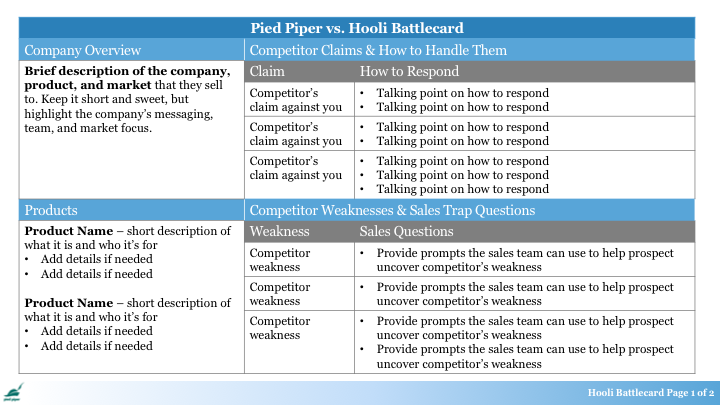Sales battlecards are one of the most common and most important sales enablement assets.
They provide an overview of a specific competitor’s company, products, and services, and provide guidelines on how to win deals against that competitor.
They’re also the ammo you give your sales reps to go into battle against your competitors. The better the cards the better your chances at beating your competitors to the deal.
So, it’s important to get them right.
In this article I’m going to walk you through why battlecards are so important, best practices for building them, and what you need to include in your battlecards to help your reps close deals.
Why Sales Needs Battlecards
There are two core reasons every sales rep needs battlecards. They help you:
- Understand the competitive landscape and how your company positions itself against other players in the market
- Understand HOW to tactically sell against specific competitors
Understanding the competitive landscape
Today’s buyer is educated. They do a ton of upfront research before ever speaking to a sales rep. In fact, 60% of buyers prefer to connect with sales during the consideration stage, after they’ve researched the options and come up with a short list.

What does this mean?
It means that today’s buyer is coming into a deal with a lot of knowledge about your company AND your competitors.
So your sales reps better know their stuff when they find themselves in a competitive situation.
Understanding how to sell tactically
Beyond educating the sales rep, another function of a battlecard is to provide guidelines and tactical tips on how to win a deal against a specific competitor.
An effective battlecard is loaded with tactics on how to sell — it is NOT a feature-by-feature comparison.
RELATED: The Power of Social Selling (+ 7 Rules for Storytelling in Sales)
Battlecards should include digestible soundbites that your reps can leverage on a call with prospects, along with insights into what has worked in the past and what hasn’t.
Best Practice for Battlecards
Before we dive into the nitty gritty about what to include in a battlecard, there are some best practices that you should know before you start building:
- Keep it short: There is a lot of information youcould include in a battlecard, but make sure you only include thenecessary information. Battlecards are meant to work like a quick reference sheet for your reps on a call. If the information is too dense, it won’t be useful for the sales reps.
- Stay up-to-date with the market: Battlecards must always be in sync with market changes. Saying the wrong thing about a competitor can land a sales rep in hot water and break trust with the prospect. Make sure you’re tracking market and competitive intelligence consistently in order to keep your battlecards updated in real-time.
- Build for sales reps: This isn’t just a list of bullet points about how you differ from the competition. You should include actionable soundbites that sales can use in conversations with prospects.
- Make it discoverable: Sales reps are busy and need battlecards to be at their fingertips. Store your battlecards in a central location where they’re easy to find and access. Your CRM, sales enablement platform, wiki, or Google Drive are all great options.
- Make it measurable: Make sure you can measure the view count (both total and unique) of your battlecards to see how often sales reps are utilizing them. Cross-referencing the view count with your win rate against a specific competitor can indicate whether or not your battlecard is effective.
- Make it branded: A little internal branding can go a long way towards driving adoption and positive impressions among the sales team.
If you follow these six rules when designing and building your battlecards, your sales reps will thank you.
RELATED: Power-Up Your B2B Sales Enablement Strategy With These Essential Tips
Now let’s get into what information you need, and how to actually put one together.
How to Build a Sales Battlecard
The information you should include in your battlecards breaks down into four separate categories:
- Competitor overview information
- Competitive sales tactics
- Win/loss insights
- Go-to-market information
Depending on your org and the needs of your sales reps, you can include all or just some of this information.
We’re going to take a look at each of these categories a little more closely so you can see how they work together.
Competitor overview
All battlecards should include a competitor overview. Your sales reps need to know at least the basics about the competition, and you don’t want them flying blind when they’re entering a deal.
The bare minimum of a competitor overview should include:
- Company name
- Website
- Location
- Number of employees
However, the more information you can include the better. For instance, you may want to include information on your competitors. Things like:
Customers: You can grab this information from the competitor’s website wherever they have logos, case studies, etc.
Partners: These can be VARs, marketing partners, etc.
Target markets and verticals: The key segments and industries your competitor is targeting.
Hiring trends: Growth (or lack thereof) in hiring. Noting which departments and positions your competitor is hiring for can be very helpful in understanding where they are making key investments.
Geographic reach: Which geographic regions your competitor is targeting.

Competitive sales tactics
An overview is important for reps to gain a baseline understanding, but what’s really impactful is giving them short, bite-sized information to leverage in competitive situations with prospects. Here are some examples of competitive tactic topics:
Claims and counters (a.k.a. Objection handling): These are specific claims your competitor makes about your company’s products and/or services, and then the corresponding counter against those claims. If you find that this section of your battlecard is rather long, you can build a separate battlecard specifically for objection handling.
Kill points: These are quick statements that are meant to knock a competitor out of a deal early on. Make sure to provide training on these so reps can use them effectively — the further along a competitor is in the deal, the less effective they will likely be.
Land mines: Questions or topics that put your company at a competitive disadvantage, which more than likely will be tied to a competitor’s strengths. Make sure to include methods on how a sales rep can effectively respond and redirect the conversation.
Warning signs: Phrases, framings, questions, or topics that signal a competitor is in a deal. Prospects often won’t share whether or not they are looking at a competitor, so it’s helpful to include clues for reps so they know how to proceed in the conversation, what questions they should ask the prospect, etc.
Copycat examples: These are examples of how a competitor has copied any of your company’s innovations. This can include product features, service offerings, or broader business strategies. Sales reps can use these to portray the competitor as a company that’s desperately trying to catch up to you, rather than an innovator.
Here are some examples of competitor overview battlecards.


Win/loss insights & stories
If I’ve learned anything in the past several years working with sales reps, it’s that they don’t thrive on cold hard numbers. They respond to stories, and you can capitalize on that by providing win/loss stories on your battlecards.
RELATED: How to Tell Captivating Stories that Drive Behavior
Here are 5 types of win/loss stories you can include on your battlecards.
Win stories: Examples of sales reps winning competitive deals. These stories should be straight from the sales rep and be full of practical advice on how to win against a specific competitor.
Loss stories: Same as above, except these should be stories about when a rep lost a deal to a competitor. These stories should demonstrate where the deal went wrong, and where a rep may have missed the opportunity to change the narrative.
“Why We Win”: A list of specific reasons why you win against a certain competitor. This should reflect your product strengths and give advice on how to steer the conversation toward the win.
“Why We Lose”: A list of reasons why you lose to a specific competitor. Similar to the above, you’ll want to provide guidance on how to steer the conversation away from a loss.
Rip-out stories: Examples of when a sales rep sold to a former customer of a competitor. Surface key moments and themes that can help in competitive opportunities.

Go-to-market information
All players in the competitive landscape approach the market differently, and it’s important to outline that for sales. GTM information is often displayed in side-by-side comparison tables to make the offerings between two competitors clear.
Here is some GTM you can include:
Messaging: How your competitor positions themselves in the market. Remember to use their own words straight from their website and/or social profiles.
Strengths and Weaknesses: What are your competitors’ strengths and weaknesses as a company and as a product. Try to frame these around your value proposition as opposed to technical features. An excellent way to draw out strengths and weaknesses is to look at third party reviews on sites like G2, TrustRadius, etc.
Key Differentiators: A list of what makes your company and product better than competitors.
Pricing and Packaging: How your competitors structure their pricing and packaging. Provide context on the strategy so reps can understand how it differs from your own.


Battlecards for the Win
Reps need to understand the competitive landscape, but they also need to understand how to leverage competitive information in the heat of the moment. Battlecards are the key to winning any competitive situation, so make sure to keep 3 things in mind when building them:
- Ensure battlecards are continuously updated with market changes, discoverable by reps, and measurable.
- Keep content short, digestible, and framed for a sales rep.
- Keep it tactical so sales can leverage soundbites and intel on the fly.
Stay tuned for the next post where we’ll show reps HOW to use battlecards to win more deals.







